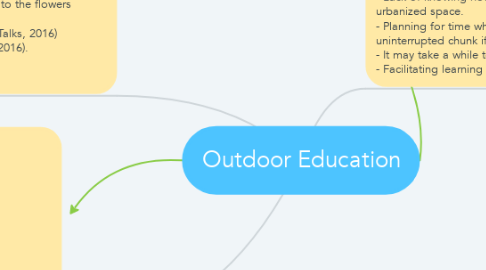Outdoor Education
by Leah Dabrowski

1. POSSIBILITY OF INQUIRY: - mathematical literacy of the whole body such as meticulously counting items collected (TedXTalks, 2016). - problem-solving and belonging and contributing such as noticing once something is removed form a living thing it cannot be put back again (TedXTalks, 2016). - inspiration by finding the beauty around oneself (TedXTalks, 2016). - outdoors as health-promotion interventions as it benefits development (TedXTalks, 2016). - natural curiosity and sense of wonder - infinite possibilities to explore interests - ideas such as how to take care of living things through watering them or singing to the flowers (TedXTalks, 2016). - experiential learning (hypothesis etc…) fostered in the natural environment (TedXTalks, 2016) - connections to the real world such as food coming from the garden (TedXTalks, 2016). - naturally differentiates learning (TedXTalks, 2016). - the arts, the sciences, and so much more!
2. References: TedXTalks. [n/a]. (2016, June 16). What Nature Teaches Children [Video file]. Retrieved from What nature teaches children | Nilda Cosco | TEDxRaleigh
3. CHALLENGES: - Fear of outdoor play; some students spend very little time outdoors and a lot of time with screens. They may observe and not know what to do at first and need that time to blossom to the outdoors. - Lack of knowing how to structure the outdoor space or a very urbanized space. - Planning for time where the Kindergarten class has that uninterrupted chunk if there is only a shared yard. - It may take a while to shift thinking. - Facilitating learning outdoors (TedXTalks, 2016).


